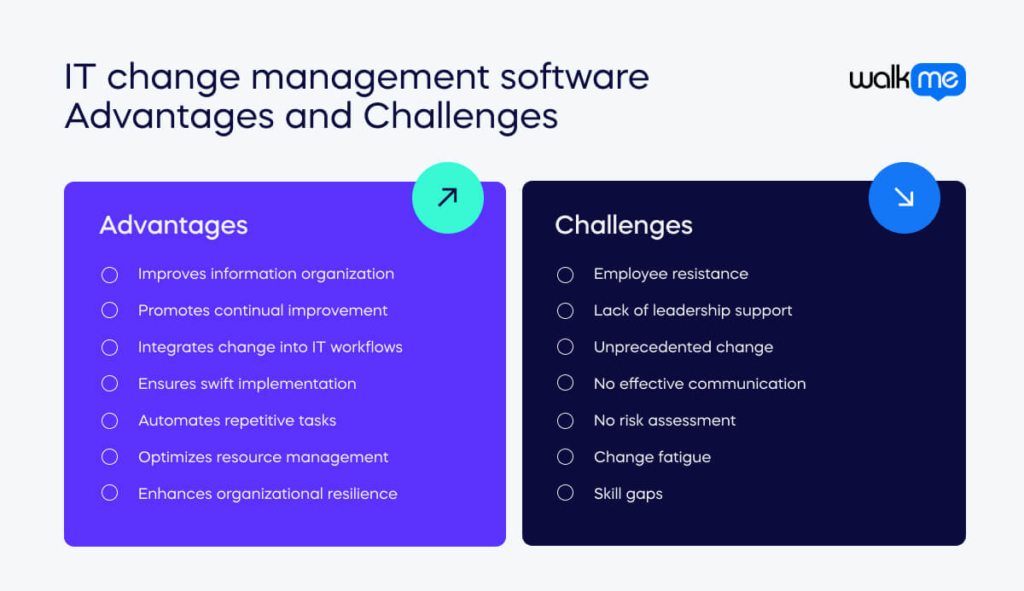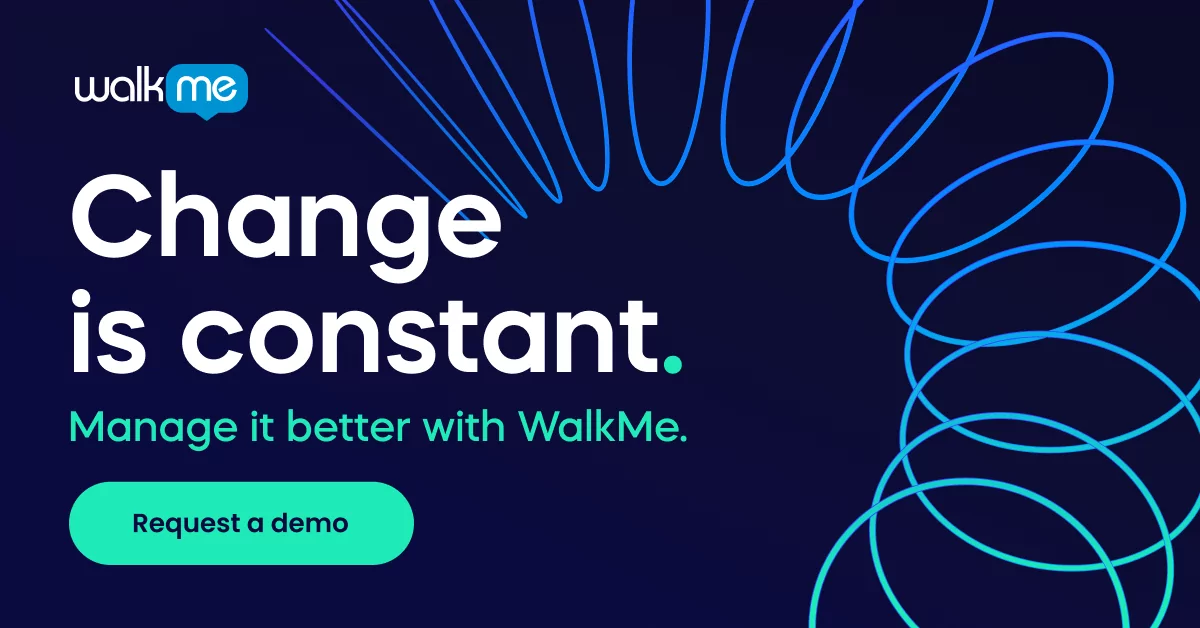IT change management practices aim to reduce incidents and meet regulatory standards. This ensures the efficient handling of changes to IT infrastructure and code. Modern approaches break down silos, provide transparency, and reduce risk.
This is true whether rolling out new services, managing existing ones, or resolving code issues. IT software solutions aid in change management, enhancing cross-functional collaboration.
This article will examine the 12 best IT change management software solutions for 2025. It will also explain what IT change management software is, its benefits, and its risks.
What is IT change management software?
IT change management software is a versatile tool. It empowers your tech team to streamline various tasks. It allows you to track and visualize all ongoing and upcoming changes in one convenient location. This optimizes the change management process. With real-time monitoring capabilities, you can keep an eye on changes as they unfold.
Change management is a vital process for IT teams. It facilitates modifications to software, systems, or IT infrastructures. It serves as a cornerstone of IT service management (ITSM), a collection of interdependent processes designed to enhance the design, delivery, and management of IT services.
Guided by frameworks like the Information Technology Infrastructure Library (ITIL), ITSM aims to standardize procedures. The goal is to ensure that changes improve operations without disrupting business functions.
12 best IT change management software in 2025
1. WalkMe
- G2 rating: 4.5 (415)
- Pricing: Contact WalkMe for pricing details.
WalkMe’s DAP works with popular business tools like Salesforce, Oracle, NetSuite, and Microsoft 360. It helps teams transition and use advanced features. IT managers can use customizable templates to create engaging walkthroughs for team members.
WalkMe’s data-driven tool gives insights into employee performance. In this way, it helps managers improve in-app instructions and user pathways. This solution boosts digital adoption by providing on-screen guidance and personalized help. It makes user experiences seamless. It also speeds up digital transformation for businesses and organizations.
Features this tool offers:
- Enhances digital adoption for businesses.
- Offers real-time help within the software interface.
- Tailors guidance based on individual user needs.
- Streamlines processes through automated task completion using AI technology.
- Creates personalized guides.
- Develops content using pre-built workflow templates.
- Provides data to optimize user experiences.
2. Freshservice
- G2 rating: 4.6 (1,189)
- Pricing: Freshservice has four different pricing packages. This depends on whether you go for the starter ($19), growth ($49), pro ($95) or enterprise ($119) package. It also has a 21-day free trial.
Freshservice, developed by Freshworks Inc., is an innovative cloud-based IT service management solution. It streamlines IT team operations across various organizations. It gives you tools that automate IT service management processes that facilitate efficient service delivery.
Freshservice features a user-friendly interface, making it accessible for both IT professionals and end-users.
As a change management software, Freshservice excels by providing a structured platform. IT teams can plan, execute, and track change processes. It centralizes the management of all change requests. This ensures that you can document, check, and implement any alterations to IT infrastructure or services.
Features this tool offers:
- Automated notifications keep agents and end users informed about change-related events.
- Tools for risk analysis and cost-benefit analysis help assess the impact of changes.
- Intelligent automation enables the automatic assessment, approval, and implementation of changes.
- A user-friendly dashboard allows you to visualize the full lifecycle of ongoing changes. It can also track progress and collaborate with the change management team on a single screen.
- A collaborative change calendar lets change managers view tasks and scheduled changes, automatically adds these to agents’ calendars, and helps set up CAB meetings by showing other agents’ schedules.
3. ChangeGear
- G2 rating: 3.9 (98)
- Pricing: Contact ChangeGear for pricing information.
ChangeGear is another popular platform ideal for IT managers and team leaders. It helps manage organizational change, whether introducing a new policy or integrating new technology.
IT leaders can use this tool to track and resolve requests and issues. The dashboard shows performance in every process. This change management software stands out for its advanced ML and AI features, which aid decision-making.
Features this tool offers:
- Built-in change workflows for ITIL, DevOps, and business processes.
- SLA management to keep changes on track.
- Change manager dashboards with visual reporting, metrics, and KPIs.
- A central repository of all changes across the enterprise to reduce risk.
- Distributed development capabilities.
4. Issuetrak
- G2 rating: 4.1 (62)
- Pricing begins at $26 per month for one agent. A free trial is also available.
Issuetrak is ticket management software. It assists organizations in handling customer support and internal issue tracking across many channels. It adapts to various business sizes and sectors and offers a robust platform for omnichannel ticket submission.
Choose Issuetrak for change management because it provides a comprehensive set of features that cater to diverse business needs. These features include help desk ticket management, complaint handling, and customer support requests.
Issuetrak stands out by accepting ticket submissions through many channels. These channels include email, web forms, and directly within the application. This capability is useful for businesses that interact with customers across various platforms.
Features this tool offers:
- Quick notes feature allows for the rapid addition of pre-written notes to issues.
- Functionality for managing customer complaints.
- Comprehensive customer support, including:
- Dedicated support department.
- 24/7 technical help.
- In-house services like site configuration and training for support agents.
- Integrations with Okta, OneLogin, Gmail, Microsoft 365, Salesforce, Google Analytics, and PowerBI.
5. ServiceNow
- G2 rating: 4.4 (1,956)
- Pricing: Contact ServiceNow for pricing options.
ServiceNow is an all-in-one solution with pre-built ITSM products. You can use it to automate and manage IT business services. This change management software manages the virtualization lifecycle and implements organizational changes.
It also has other features like infrastructure discovery and IT governance. Generating KPIs and accessing reports on an employee’s adjustment to change is simple.
Its AI tools also enhance the customer experience through predictive analytics.
Features this tool offers:
- Simplifies Change Advisory Board (CAB) meetings. This helps managers schedule, plan, and manage them.
- Automatic risk and impact calculation that adjusts in real-time.
- Detects changes that overlap or conflict.
- Integrates with other ServiceNow applications.
- One system for all records and a single change calendar.
6. Userguiding
- G2 rating: 4.6 (242)
- Pricing: Userguiding offers a basic, professional, and corporate package. The basic package starts at $89 for 2500 users, and there is also a 14-day free trial.
UserGuiding specializes in improving in-app user onboarding. It does this through features like product tours, checklists, and resource centers. It focuses on personalized experiences and provides tools for feedback collection and user engagement.
As an IT change management tool, UserGuiding helps with user onboarding for new software or updates. It offers no-code interactive guides and checklists to assist organizations in introducing new features. This ensures users understand and adapt to changes.
Features this tool offers:
- User segmentation for unique experiences based on behavior and characteristics.
- Creation of step-by-step guides to highlight key features and functionalities.
- Tours designed for effective product usage, especially during updates or new platform introductions.
- Analytics track user behavior and engagement.
- Personalization which enhances onboarding effectiveness.
7. SysAid
- G2 rating: 4.5 (676)
- Pricing: Contact SysAid for a quote. There is also a free trial per agent available.
SysAid is an ITSM platform with features for controlling and managing change requests based on ITIL’s best practices. It includes pre-configured workflow templates for various change scenarios involved in planning, consideration, approval, and execution. Users can create their own change process templates and configure multi-level authorization and risk assessment.
They can assess the potential risk of each change and use the approval process to ensure compliance with company strategies and policies before execution. Stakeholders outside of IT can participate in workflows, and reporting tools help track the impact of their work.
Features this tool offers:
- Workflow templates are set up for different change scenarios or tailored to user needs.
- Based on ITIL best practices.
- Automates service desk processes to boost efficiency from request to development teamwork.
- Includes a CMDB feature to ensure proper configuration of all IT assets for service delivery.
- Check the risk of suggested changes and involve external stakeholders if needed.
- Approval process occurs at different levels. This is to ensure changes follow company policies before implementation.
8. Giva
- G2 rating: 4 (2)
- Pricing: Contact Spendwise for pricing information.
Giva is an ITIL-aligned change management tool. It combines knowledge management, IT change management, and asset management into one app. It supports process definition and documentation. Giva offers customizable and configurable out-of-the-box services.
Features this tool offers:
- Customizable fields, screens, options, and rules
- Attach files to change records
- Centralized IT change schedule
- ITIL-compliant workflow for routing IT changes
- Option to expedite routine changes
- Automatic notifications to the IT change manager and advisory board
- Send notifications via pager, email, or cell phone
9. ManageEngine
- G2 rating: 4.2 (227)
- Pricing: Different packages are available. It begins with the standard edition, which starts at $1195 for 10 technicians.
ManageEngine is a comprehensive IT Service Management (ITSM) suite. It has a built-in IT Asset Management (ITAM) system and Configuration Management Database (CMDB). It assists in risk assessment and change planning. The PinkVerify-certified IT change management module, enables IT teams to implement changes with minimal risk using a visual workflow designer.
Features this tool offers:
- Send automated notifications and announcements to end users
- Access a change calendar
- Customize automated change workflows
- Check, focus on, and schedule changes with input from the CAB
- Use implementation checklists
10. Viima
- G2 rating: 4.8 (17)
- Pricing: Free, basic, pro, and advanced packages are available. The basic plan costs $79 per month for ten users.
Viima is an organizational change management system with many ideation boards. These boards can be used for a specific change process. It offers single sign-on and individual access control for simultaneous implementation and tracking of various changes.
The user-friendly dashboard provides insights into new methods and technology integration. Viima also includes commenting, liking, sharing, evaluation, and impact assessment tools.
Features this tool offers:
- Built-in discussions for team collaboration
- Automated idea scoring to focus on initiatives
- Idea challenges to inspire innovative solutions from employees
- Mobile-friendly platform
11. TopDesk
- G2 rating: 4.1 (27)
- Pricing: Contact TopDesk for pricing options.
TopDesk is a service management platform that simplifies IT service processes. Its change management tool automates workflows. Its change explorer provides a comprehensive view of all changes and tasks. TopDesk also features an editable change planner that displays everyone’s schedule.
Features this tool offers:
- Automated processes
- Useful task lists
- Clear schedules for change stakeholders
- Instant access to all relevant information
12. Guru
- G2 rating: 4.7 (1745)
- Pricing: Guru offers three pricing options: a free trial, an all-in-one starting at $15, and an enterprise option.
Guru is a knowledge management tool for employees to access and share trusted information within a company. It offers AI-powered solutions for enterprise search, intranet, and wiki. Guru focuses on improving the employee experience and streamlining information access. It also ensures security as a comprehensive source of truth for businesses.
Features this tool offers:
- Centralizes company information for easy access by team members
- Supports creating, sharing, and updating knowledge
- Provides a snapshot of web pages and search bar for specific terms
- Uses AI for instant answers
- Supports internal communication, onboarding, and remote work
- Emphasizes communication, training, and support during changes
- Allows creating and sharing knowledge cards
- Helps keep everyone informed and aligned during changes

What are the benefits of IT change management software?
The vital benefits of IT change management software are:
Improves information organization
IT change management tools help organize information. These include project documentation, process changes, and training materials. They offer centralized repositories, knowledge bases, and version control systems.
This makes it easier to capture, store, and retrieve knowledge. As a result, you can promote knowledge sharing and reduce duplication of efforts. You can also ensure continuity during and after the change process with this type of software.
Promotes continual improvement
These tools create a culture of continual improvement and provide platforms for employees to contribute insights and feedback. Involving employees in the change process enhances the organization’s ability to implement changes and boosts employee engagement, morale, and buy-in.
Integrates change into IT workflows
Effective IT change management tools make change a natural part of the workflow and company culture. They streamline technical aspects such as software updates, hardware changes, and system configurations. These tools provide visibility into the impact of changes. This helps identify potential improvements.
Ensures swift implementation
Change management tools enable swift implementation of changes according to industry standards. They simplify the complexity of change management, allowing organizations to focus on future goals instead of present challenges.
Automates repetitive tasks
These software solutions automate repetitive tasks like tracking analytics and collecting feedback. This allows employees to give their attention to more important tasks. The software also helps identify and manage risks proactively. This reduces the chances of project failure and costs.
Optimizes resource management
IT change managers use the technology to optimize resources, expect roadblocks, and plan. This leads to a smoother and faster implementation process. Effective change management improves IT operations, reducing future IT incidents and problems.
Detailed analytics and reports enable continuous improvement and accountability. Users can assess the impact of change initiatives and adjust strategies as needed.
Enhances organizational resilience
IT change management software facilitates smoother transitions during change and enhances business resilience. Choosing the right software helps businesses manage and thrive through change. This secures a competitive edge in an evolving market.
What are the challenges of IT change management software?
It’s also important to be aware of the main challenges of IT change management software.
These are:
Employee resistance
People naturally resist following processes. This is especially true in fast-moving IT environments where frequent changes amplify this resistance. An organization can deal with changes like standard, normal, urgent, and retro/emergency. These can overwhelm IT development and support teams.
Frequent change requests and approval processes can make it difficult for them to keep up. Change managers must proactively address this resistance. They should communicate the benefits and rationale behind the change process. They must also emphasize the importance of compliance to gain stakeholder buy-in.
Lack of leadership support
Strong leadership support is crucial for successful IT change management. Without it, employees may not take the change seriously or feel motivated to adapt. Leaders at all levels must show their commitment to the change.
They could do this by communicating its importance to employees, as outlined in the change management plan. This visible support helps to motivate and engage employees in the change process.
Unprecedented change
In fast-moving IT environments, changes occur frequently and unexpectedly. This can overwhelm teams and leave insufficient time for thorough planning and analysis. Change management processes must remain agile, flexible, and adaptable. This is so that it can keep up with the dynamic nature of the IT landscape.
No effective communication
Inadequate or ineffective communication can lead to confusion, rumors, and resistance. Establishing a clear and consistent communication plan is essential. To communicate any changes, use many channels, such as emails, meetings, and the intranet.
Provide regular updates on the change’s progress. Address concerns and emphasize the importance of change management skills. This ensures everyone stays informed and engaged.
No risk assessment
Rapid changes increase the potential for unexpected consequences. These include outages, system failures, security breaches, or service disruptions. IT change managers must focus on risk assessment and mitigation strategies.
Conduct thorough risk assessments before approving and implementing changes. Identify potential risks and their impacts on critical systems and services. Develop contingency plans to address possible issues. It can also reduce downtime in case of unexpected incidents.
Change fatigue
Change fatigue occurs when employees are overwhelmed by many changes happening simultaneously or in a short period. This leads to resistance, burnout, and decreased productivity.
To overcome this, plan the timing and sequencing of changes. Avoid implementing too many changes at once. Provide enough time for employees to adapt. Track the impact of changes on employees and offer support and resources to help them cope.
Skill gaps
Fast-moving IT environments need a skilled and experienced workforce to put in place and manage changes.
Change managers get knowledge about the company’s IT infrastructure, interconnections, dependencies, and impacts. A significant knowledge gap often arises when they leave, or you replace them.
Finding and retaining individuals with the right expertise can be challenging. Companies need to invest in employee development to bridge these gaps. In this way, they can also build a capable and resilient team.
Next steps for IT change management software
IT change management software is essential for any modern business. It keeps all stakeholders informed about changes and ensures they work together. Within IT teams, developers and IT operations often have different priorities.
Developers want to release code without extra paperwork. IT operations aim to reduce risk, maintain detailed records, and avoid incidents. Asking developers to document changes can slow them down. Removing approval checks can feel risky for ops teams. With rising expectations for reliable, high-performing services, managing these demands takes more effort.
To overcome these challenges, embrace collaborative practices and tools. Always show their value to staff. The best IT change management tool will meet your business’s unique needs, automate the process, and integrate with other technologies. Change is essential for growth. But it doesn’t have to be complicated, risky, or time-consuming with the right tools.


